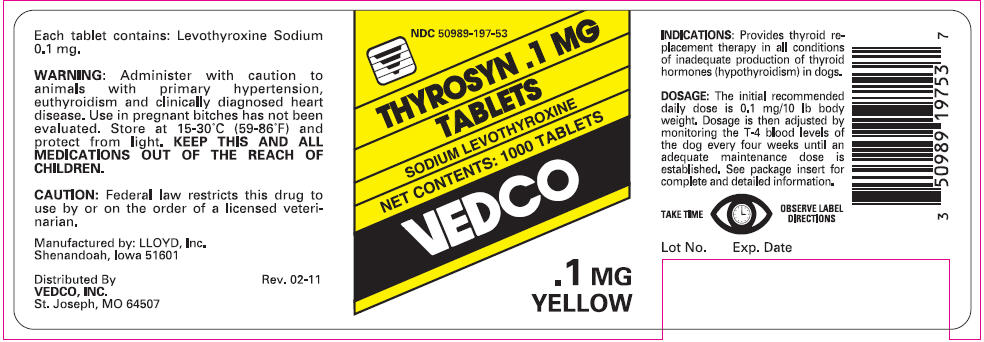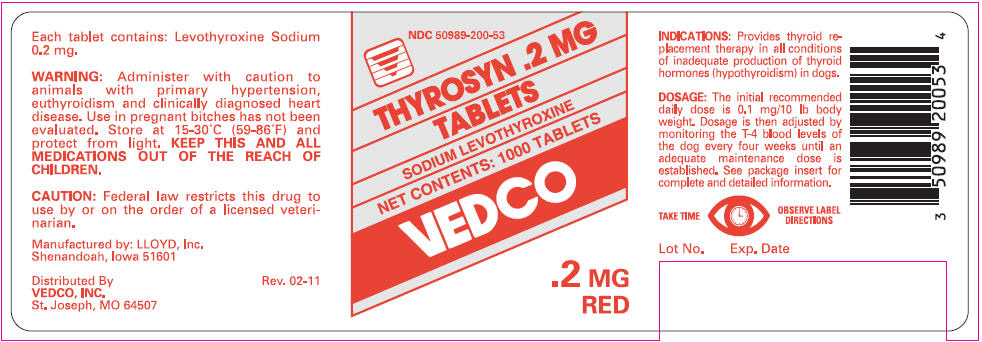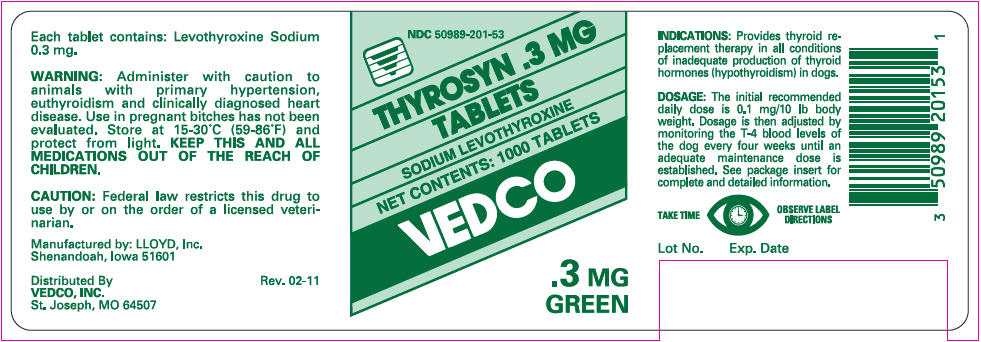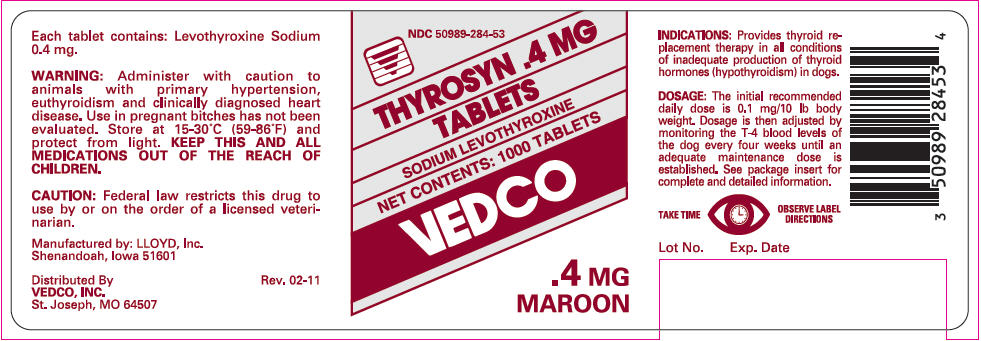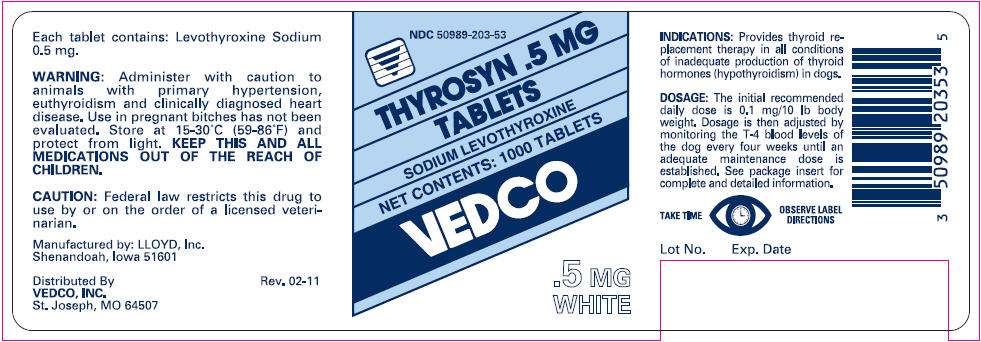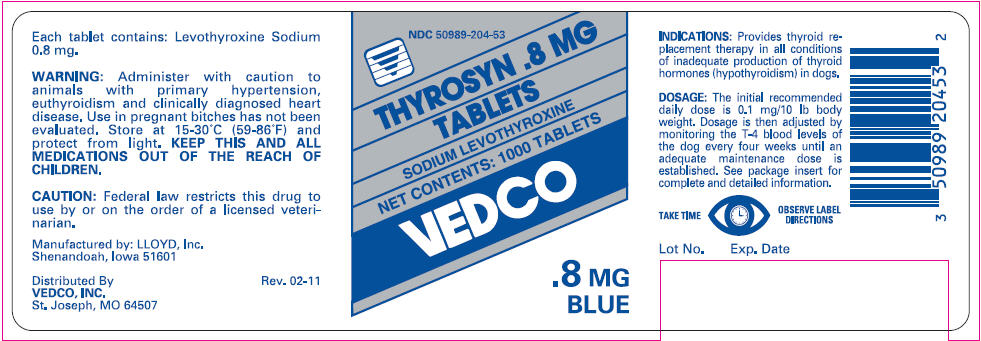Caution
Federal law restricts this drug to use by or on the order of a licensed veterinarian.
Description
Each Levothyroxine Sodium Tablet provides synthetic crystalline levothyroxine sodium (L-thyroxine).
Action
Levothyroxine sodium acts as does endogenous thyroxine, to stimulate metabolism, growth, development and differentiation of tissues. It increases the rate of energy exchange and increases the maturation rate of the epiphyses. Levothyroxine sodium is absorbed rapidly from the gastrointestinal tract after oral administration. Following absorption, the compound becomes bound to the serum alpha globulin fraction. For purposes of comparison 0.1 mg of levothyroxine sodium elicits a clinical response approximately equal to that produced by one grain (65 mg) of desiccated thyroid.
Indications
Provides thyroid replacement therapy in all conditions of inadequate production of thyroid hormones. Hypothyroidism is the generalized metabolic disease resulting from deficiency of the thyroid hormones levothyroxine (T4) and liothyronine (T3). Levothyroxine sodium will provide levothyroxine (T4) as a substrate for the physiologic deiodination to liothyronine (T3). Administration of levothyroxine sodium alone will result in complete physiologic thyroid replacement.
Canine hypothyroidism is usually primary, i.e., due to atrophy of the thyroid gland. In the majority of cases the atrophy is associated with lymphocytic thyroiditis and in the remainder it is non-inflammatory and as of yet unknown etiology. Less than 10 percent of cases of hypothyroidism are secondary, i.e., due to deficiency of thyroid stimulating hormone (TSH). TSH deficiency may occur as a component of congenital hypopituitarism or as an acquired disorder in adult dogs, in which case it is invariably due to the growth of a pituitary tumor.
Hypothyroidism in the Dog
Hypothyroidism usually occurs in middle-aged and older dogs although the condition will sometimes be seen in younger dogs of the larger breeds. Neutered animals of either sex are also frequently affected, regardless of age. The following are clinical signs of hypothyroidism in dogs:
-
- Lethargy, lack of endurance, increased sleeping
-
- Reduced interest, alertness and excitability
-
- Slow heart rate, weak apex beat and pulse, low voltage on ECG
-
- Preference for warmth, low body temperature, cool skin
-
- Increased body weight
-
- Stiff and slow movements, dragging of front feet
-
- Head tilt, disturbed balance, unilateral facial paralysis
-
- Atrophy of epidermis, thickening of dermis
-
- Surface and follicular hyperkeratosis, pigmentation
-
- Puffy face, blepharoptosis, tragic expression
-
- Dry, coarse, sparse coat, slow regrowth after clipping
-
- Retarded turnover of hair (carpet coat of boxers)
-
- Shortening or absence of estrus, lack of libido
-
- Dry feces, occasional diarrhea
-
- Hypercholesterolemia
-
- Normochromic, normocytic anemia
-
- Elevated serum creatinine phosphokinase
Contraindications
Levothyroxine sodium therapy is contraindicated in thyrotoxicosis, acute myocardial infarction and uncorrected adrenal insufficiency. Use in pregnant bitches has not been evaluated.
Precautions
The effects of levothyroxine sodium therapy are slow in being manifested. Overdosage of any thyroid drug may produce the signs and symptoms of thyrotoxicosis including but not limited to polydipsia, polyuria, polyphagia, reduced heat tolerance and hyperactivity or personality change. The 0.7 mg tablet contains FD&C yellow #5 (tartrazine) which has been associated with allergic type reactions (including bronchial asthma) in susceptible humans. It is unknown whether such a reaction could also occur in dogs. Administer with caution to animals with clinically significant heart disease, hypertension or other complications for which a sharply increased metabolic rate might prove hazardous.
Adverse Reactions
There are no particular adverse reactions connected with L-thyroxine therapy at the recommended dosage levels. Overdose will result in the signs of thyrotoxicosis listed above under precautions.
Dosage
The initial recommended daily dose is 0.1 mg/10 lb body weight. Dosage is then adjusted according to patient's response by monitoring T4 blood levels at time intervals of four weeks.
Administration
L-thyroxine tablets may be administered orally or placed in the food.
Dosage forms available
0.1 mg, 0.2 mg, 0.3 mg, 0.4 mg, 0.5 mg, 0.6 mg, 0.7 mg, and 0.8 mg.
Storage
Store at 15°-30°C (59°-86°F) and protect from light.
PRINCIPAL DISPLAY PANEL - .1 MG Tablet Bottle Label
NDC 50989-197-53
THYROSYN .1 MG
TABLETS
SODIUM LEVOTHYROXINE
NET CONTENTS: 1000 TABLETS
VEDCO
.1 MG
YELLOW
PRINCIPAL DISPLAY PANEL - .2 MG Tablet Bottle Label
NDC 50989-200-53
THYROSYN .2 MG
TABLETS
SODIUM LEVOTHYROXINE
NET CONTENTS: 1000 TABLETS
VEDCO
.2 MG
RED
PRINCIPAL DISPLAY PANEL - .3 MG Tablet Bottle Label
NDC 50989-201-53
THYROSYN .3 MG
TABLETS
SODIUM LEVOTHYROXINE
NET CONTENTS: 1000 TABLETS
VEDCO
.3 MG
GREEN
PRINCIPAL DISPLAY PANEL - .4 MG Tablet Bottle Label
NDC 50989-284-53
THYROSYN .4 MG
TABLETS
SODIUM LEVOTHYROXINE
NET CONTENTS: 1000 TABLETS
VEDCO
.4 MG
MAROON
PRINCIPAL DISPLAY PANEL - .5 MG Tablet Bottle Label
NDC 50989-203-53
THYROSYN .5 MG
TABLETS
SODIUM LEVOTHYROXINE
NET CONTENTS: 1000 TABLETS
VEDCO
.5 MG
WHITE
PRINCIPAL DISPLAY PANEL - .6 MG Tablet Bottle Label
NDC 50989-240-53
THYROSYN .6 MG
TABLETS
SODIUM LEVOTHYROXINE
NET CONTENTS: 1000 TABLETS
VEDCO
.6 MG
PURPLE
PRINCIPAL DISPLAY PANEL - .7 MG Tablet Bottle Label
NDC 50989-283-53
THYROSYN .7 MG
TABLETS
SODIUM LEVOTHYROXINE
NET CONTENTS: 1000 TABLETS
VEDCO
.7 MG
ORANGE
PRINCIPAL DISPLAY PANEL - .8 MG Tablet Bottle Label
NDC 50989-204-53
THYROSYN .8 MG
TABLETS
SODIUM LEVOTHYROXINE
NET CONTENTS: 1000 TABLETS
VEDCO
.8 MG
BLUE
Vedco Inc.
